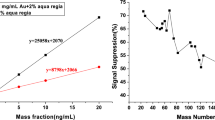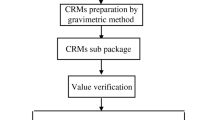Abstract
Gravimetrically prepared mono-elemental reference solutions having a well-known mass fraction of approximately 1 g/kg (or a mass concentration of 1 g/L) define the very basis of virtually all measurements in inorganic analysis. Serving as the starting materials of all standard/calibration solutions, they link virtually all measurements of inorganic analytes (regardless of the method applied) to the purity of the solid materials (high-purity metals or salts) they were prepared from. In case these solid materials are characterized comprehensively with respect to their purity, this link also establishes direct metrological traceability to The International System of Units (SI). This, in turn, ensures the comparability of all results on the highest level achievable. Several national metrology institutes (NMIs) and designated institutes (DIs) have been working for nearly two decades in close cooperation with commercial producers on making an increasing number of traceable reference solutions available. Besides the comprehensive characterization of the solid starting materials, dissolving them both loss-free and completely under strict gravimetric control is a challenging problem in the case of several elements like molybdenum and rhodium. Within the framework of the European Metrology Research Programme (EMRP), in the Joint Research Project (JRP) called SIB09 Primary standards for challenging elements, reference solutions of molybdenum and rhodium were prepared directly from the respective metals with a relative expanded uncertainty associated with the mass fraction of U rel(w) < 0.05 %. To achieve this, a microwave-assisted digestion procedure for Rh and a hotplate digestion procedure for Mo were developed along with highly accurate and precise inductively coupled plasma optical emission spectrometry (ICP OES) and multicollector inductively coupled plasma mass spectrometry (MC-ICP-MS) methods required to assist with the preparation and as dissemination tools.





Similar content being viewed by others
References
Güttler B, Richter W (2009) Traceability of chemical measurement results. Chimia 63:619–623
Bureau International des Poids et Mesures (2008) International vocabulary of metrology—basic and general concepts and associated terms (VIM). JCGM 200
Bureau International des Poids et Mesures (2006) The international system of units (SI), 8th edition
Kipphardt H, Matschat R, Rienitz O, Schiel D, Gernand W, Oeter D (2006) Traceability system for elemental analysis. Accred Qual Assur 10:633–639
Richter S, Sargent M, Schiel D, Kipphardt H (2013) Known purity—the fundament of element determination by atomic spectrometry. J Anal At Spectrom 28(10):1540–1543
Rienitz O, Schiel D, Görlitz V, Jährling R, Vogl J, Lara-Manzano JV, Zoń A, Fung W, Buzoianu M, Caciano de Sena R, Augusto dos Reis L, Valiente L, Yim Y, Hill S, Champion R, Fisicaro P, Bing W, Turk GC, Winchester MR, Saxby D, Merrick J, Hioki A, Miura T, Suzuki T, Linsky M, Barzev A, Máriássy M, Cankur O, Ari B, Tunç M, Konopelko LA, Kustikov YA, Bezruchko M (2012) CCQM-K87 “Mono-elemental calibration solutions”. Metrologia, Tech Suppl 49:08010
Jun W, Hongmei L, Liandi MA (2009) NIM’s role in developing national system of metrology in chemistry for food analysis, IMEKO World congress fundamental and applied metrology, 6–11, Lisbon, Portugal, 2583–2587
Kipphardt H, Czerwensky M, Matschat R (2005) ICP-MS analysis of high purity molybdenum used as SI-traceable standard of high metrological quality. J Anal At Spectrom 20:28–34
Felber H, Weber M, Rivier C (2002) Final report on key comparison CCQM-K8 of monoelemental calibration solutions. Metrologia,Tech Suppl 39:08002
Beck CM, Salit ML, Water RL Jr, Butler TA, Wood LJ (1993) Preparation and certification of a rhodium standard reference material solution. Anal Chem 85:2899–2902
Hauswaldt A-L, Rienitz O, Jährling R, Fischer N, Schiel D, Labarraque G, Magnusson B (2012) Uncertainty of standard addition experiments: a novel approach to include the uncertainty associated with the standard in the model equation. Accred Qual Assur 17:129–138
Serapinas P, Labarraque G, Charlet P, Ežerinskis Ž, Juzikienė V (2010) Method of standard additions for arsenic measurements in water by ICP sector field mass spectrometry at accuracy comparable to isotope dilution. J Anal At Spectrom 25:624–630
Salit ML, Turk GC (1998) A drift correction procedure. Anal Chem 70:3184–3190
Salit ML, Turk GC (2005) Traceability of single-element calibration solutions. Anal Chem 77:136 A–141 A
Salit ML, Turk GC, Lindstrom AP, Butler TA, Beck CM II, Norman B (2001) Single-element solution comparisons with a high-performance inductively coupled plasma optical emission spectrometric method. Anal Chem 73:4821–4829
Nater R, Reichmuth A, Schwartz R, Borys M, Zervos P (2009) Dictionary of weighing terms. Springer, Berlin
Spieweck F, Bettin H (1992) Review: solid and liquid density determination. Tech Mess 59:285–292
Bowman HA, Schoonover RM, Jones MW (1967) Procedure for high precision density determinations by hydrostatic weighing. J Res Natl Bur Stand C Eng Instrumen 71C:179–198
Bureau International des Poids et Mesures (2008) Evaluation of measurement data—guide to the expression of uncertainty in measurement, JCGM 100
ISO Guide 35:2006, Reference materials—general and statistical principles for certification
Acknowledgments
Financial Support by EMRP (the European Metrology Research Programme) is gratefully acknowledged (EMRP SIB09, “Primary Standards for Challenging Elements”). The EMRP is jointly funded by the EMRP participating countries within EURAMET and the European Union.
Author information
Authors and Affiliations
Corresponding author
Additional information
Published in the topical collection Reference Materials for Chemical Analysis with guest editors Hendrik Emons and Stephen A. Wise.
Appendix
Appendix
Bracketing plus internal standard method
In the case of a linear relationship of the measured signal intensity I of an element E or isotope I and the amount of substance n of this element or isotope carried into the measurement device (e.g., ICP OES), a straight line connecting the two standard solutions (bracket) can be assumed. Its parameters slope tanα and y-intercept R 0 can then be applied to calculate the mass fraction w x of the element in the original sample. If all solutions were additionally doped with an internal standard Y, having a mass fraction of w y, the straight line can be expressed via signal intensity and amount of substance ratios, respectively (Fig. 6).
Relationship between signal intensity ratios R and amount of substance ratios r used to derive Eq. (10) for the calculation of the mass fraction of the analyte element in the original sample (x)
In case the isotopic composition of the element of interest is the same in the sample and in the standard, the ratio of the molar masses cancels from the last equation.
In case a mass spectrometer is used and the element of interest has at least two isotopes, the amount of substance fractions x of the isotope of the analyte element measured in sample x and in standard z have to be taken into account.
Quantities, indices, and other symbols
Table 3 summarizes all quantities, indices, and additional symbols used throughout the document.
Rights and permissions
About this article
Cite this article
Kaltenbach, A., Noordmann, J., Görlitz, V. et al. Gravimetric preparation and characterization of primary reference solutions of molybdenum and rhodium. Anal Bioanal Chem 407, 3093–3102 (2015). https://doi.org/10.1007/s00216-014-8395-2
Received:
Revised:
Accepted:
Published:
Issue Date:
DOI: https://doi.org/10.1007/s00216-014-8395-2





